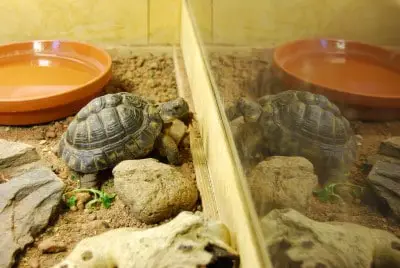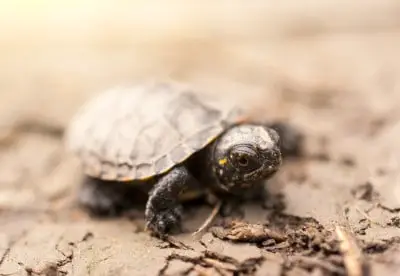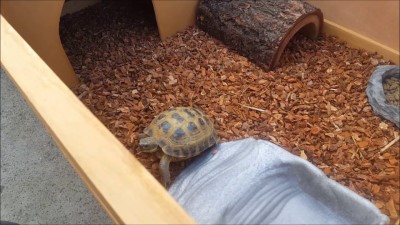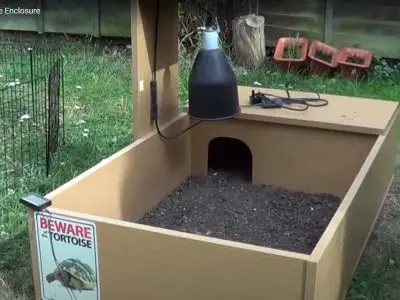If you have kept a pet before, you know that they can run away in search of their freedom. Tortoises are not an exception when it comes to this, and they will look for every opportunity to do so. Whether your tortoise runs away due to curiosity or to enjoy their freedom, we understand it is a matter of concern that requires attention.
If your pet feels uncomfortable in their new home, they will run away to a place and hide where they feel safe. Thus, as a new tortoise owner, you should secure your pet’s enclosure, especially when new, to prevent them from running away.
If you want to find out why your tortoise is running away, this is the ultimate guide for you. We help you understand why tortoises run away, whether a lost tortoise can find its way home, and tips to prevent your tortoise from escaping. Read through the rest of the sections to find out all the answers you need.
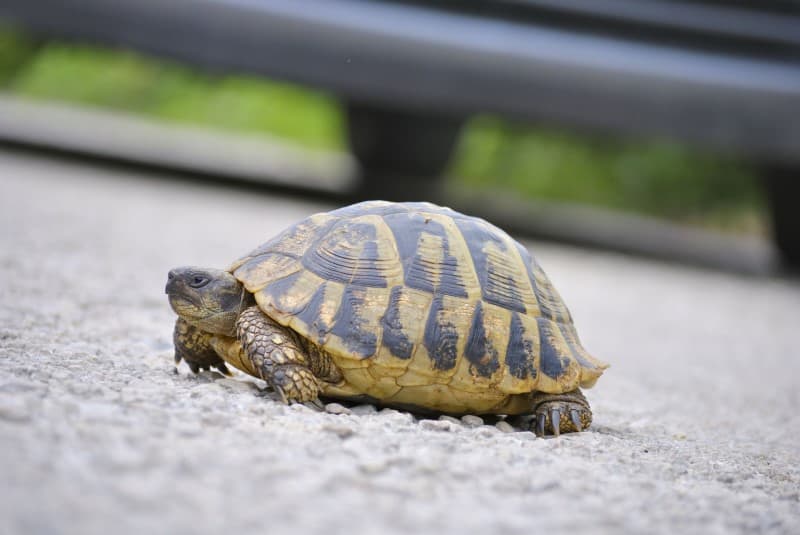
Why Do Tortoises Run Away?
Tortoises are escape artists if they have a reason to run away, as they will evade enclosures and deal with any barrier until they attain their freedom. Given that tortoises are slow animals losing them can cause panic for most owners, with theft being the first thing that comes to their minds. However, understanding that your pet could be trying to run away from the first day you bring them to your home should enable you to figure out how to start your search rather than soaking in anxiety.
Tortoises will run away if their enclosure is uncomfortable, if they feel threatened, or if they are in a new environment. Generally, these creatures love ample space and would not like to be enclosed all their life. They would want a space to bask, move around and hide.
While constructing an enclosure for them, ensure it has all these facilities for your pet to be comfortable. You should also supply something for your pet to climb in their enclosure. To fit all these items, a 3-inch by 4-inch enclosure will be ideal.
In addition to a sizable enclosure, you should ensure that the enclosure is at the right temperature for your pet to be happy and healthy. Tortoises thrive in terrestrial areas. Therefore, putting them in a very cold enclosure will give them a reason to run away. If you want your tortoise to settle in the enclosure for long, you should supply an environment that mimics the terrestrial area.
An ideal tortoise enclosure should have a hot basking space between 90 and 95 degrees Fahrenheit, a cooler shade of around 70 degrees Fahrenheit, and a warm space of around 90 degrees Fahrenheit. You should ensure these temperatures are always correct by installing a thermometer to avoid subjecting your pet to extreme conditions and cause discomfort, prompting them to run away.
Finally, you should provide food and water for your tortoise in their enclosure. Tortoises are herbivores, and supplying them with fruits and vegetables will make them stick with you for longer. You should also give your pet water in a shallow but stable bowl. Your tortoise may choose to drink or soak in this water, and you should change it daily to ensure a clean supply.
During winter, you can spray your pet enclosure to raise the humidity. This is useful, especially if you have young tortoises, to prevent shell distortion or pyramiding. Denying your pet these basics will make them run away and meet their needs by themselves.
Tortoises tend to run away when placed in a new environment. Unfamiliar spaces can make your tortoise feel uncomfortable, just like human beings. If they had a terrifying shipping experience while heading to their new environment, they will get stressed out and want to leave the new environment.
Therefore, if you notice that your pet is uncomfortable after bringing them to your home, you should give them time to adjust. This adjustment might take a few weeks or months, during which they may attempt several escapes.
Finally, a tortoise will run away if it feels threatened. Tortoises will feel threatened by loud vibrations, other pets in your household, members of your family, and even other tortoises. Thus, if you have household items such as vacuum cleaners, which produce high vibrations, use them away from your tortoise to prevent anxiety and stress.
While your cats and pets may be affectionate towards you, your tortoise will consider them a threat, and you should prevent them from getting too close to it. If your pet is not used to human interactions, they will see you and other members of your household as a terrifying creature given your size differences and may want to run away. Therefore, you should give it time and encourage other members of your household to stay away until your pet adjusts to your company. Putting many tortoises in one enclosure can also make your new pet threatened and run away.
Can a Lost Tortoise Find Its Way Home?
Tortoises can escape from your sight in just a blink of an eye. When they do this, it is your responsibility to find them as your pet will go about its business depending on its reasons for escape.
When a tortoise runs away, it will not find its way home but hide in its new environment. Given that they are burrowing creatures, they will find shelter underground by digging up to 40 burrows in a single area. The depth of these burrows will vary depending on the tortoise’s size and needs.
Usually, a tortoise will hide to take shelter from either too hot or cold temperatures by finding a comfortable range. They may also hide from the rain. If your pet feels threatened, they may opt to hide rather than retreating into their shells. Also, during winter, they will hide in the burrows for their deep sleep. These burrows are comfortable spaces for them as they can balance their body temperatures to conserve most of their energy.
Finally, the female tortoises will protect their eggs by nesting near burrows rather than inside, enabling them to hide their eggs should they see their predators preying on them.
How Far Can a Tortoise Travel in a Day?
Tortoises are slow animals, but, in reality, they can travel faster than expected. This way, they may end up covering shocking distances. Given that tortoises are not built for strenuous activities, we can estimate the distance they can cover theoretically based on their coverage per hour.
A tortoise can travel between 300 meters to 100 kilometers in a day. However, this distance is dependent on the size, species, and age of the tortoise. For instance, giant tortoises are slower and will cover a shorter distance compared to the smaller tortoise. Also, pet tortoises can travel faster, especially if you allow them to pace around while in captivity.
The giant tortoise is considered the slowest in the tortoise family, with a speed of 60 meters per hour. This means that this tortoise will cover 300 meters in a day, which sums up to 10 kilometers in a month. While this speed is not impressive, it is beneficial to a giant tortoise owner, especially if they attempt to run away. They can rest assured that their tortoise is within their vicinity even a month after losing it. Also, given its big size, it will be easier to spot a lost giant tortoise than the other species.
In the desert, some tortoise species can cover up to 5 kilometers per hour; hence, should not be termed slow. This implies that such tortoises will cover 120 kilometers if they spend their whole day walking. However, these are theoretical estimations since even if tortoises walked for the entire day, they would not maintain the same speed due to fatigue, after which they may slow down, covering less distance in a day.
Also, given that they are reptiles and hence ectotherms, they will become so hot if they walk for long under the sun, impacting their health or resulting in death before they finish their race. Conclusively, we can state that a tortoise can travel 30 to 60 kilometers in a day, with the theoretical maximum being 120 kilometers.
How To Find a Missing Tortoise
It is normal for a tortoise to run away, and you should not blame this on yourself as a tortoise owner. Your pet could be out and about or just chilling in a burrow; thus, knowing how to find it is important before their predator gets hold of them. Since tortoises are herbivores, you can rest assured that your pet will not starve to death after running away.
Once you notice your pet is missing, start by calling out all your household members to help in the search. You should search carefully around your home, given that tortoises camouflage with the environment and can seem invisible. While searching around, pay attention to burrows since tortoises are burrowing creatures.
If your tortoise gets lost, especially around the warmer or colder season, they could be hiding in a burrow to deal with the adverse weather conditions. You should also check around rocks and plants, which are a tortoise’s favorite spots.
If you have tried searching outdoors with no result, you can check indoors as your pet may have run away from their enclosure while looking for a shade. Tortoises will hide under or inside items. Thus, it will be wise to check your refrigerator, under the sofa, open cabinets, and spaces your pet can fit in around your house. You can use fruits or water to lure them out of their hideouts, but this technique is not guaranteed to work.
While searching for your pet, you should try to be strategic by learning their behavioral patterns. For instance, tortoises will come out of their hiding areas when the sun goes up. Thus, you can go outside in the morning as the sun rises and try to see whether your pet could be out basking.
If all the above techniques do not work, then it may be time to alert your neighbors to assist you in the search as your pet may have run away past your yard. You should alert them that your pet is missing, and if they see any tortoise, it is probably yours. This way, they will start looking for it and will not mistake it for a wild tortoise. If they find it, they will also be protective of it rather than releasing it to the wild.
If two or more days pass and you haven’t located your tort, you should contact your vet and local authorities within a 20-mile radius over your missing pet. You can send them a quality photo of your pet and show people around if they see it. Notifying the authority will also ensure you get your pet back should someone rescue it rather than it being taken to the zoo. You can also use local cable television stations to make repeated announcements concerning your lost tortoise. The more pictures and information you circulate, the higher your chances of finding your pet.
Finally, you can post an advert on your local paper or social media handles about your missing pet. While doing this, ensure you post quality photos to give the correct impression of what exactly your pet looks like. Good images also enable you to claim ownership in case you recover your pet. If you microchipped your tortoise, you should keep a note of the type of chip and serial number and include these details in the notices you issue.
While you may be tempted to offer a reward to anyone who finds your tortoise, this is not a good idea as cons may turn up, or other people’s tortoises may be stolen and brought to you. Instead, rely on the goodwill of people to find your pet and bring it safely to you.
Tips To Prevent Your Tortoise From Escaping
As a tortoise owner, you cannot always spend your time monitoring your pet’s movement. At the same time, you would not want to lose your pet, which is why you can take measures to prevent it from escaping.
To prevent your tortoise from escaping, start by securing its enclosure, especially if your pet lives outside. You should check for damages created by rodents and predators as they try to access the enclosure and fill the gaps. Your tortoise is keen on these spaces and will squeeze itself through if you leave them open. You can also fence your property, especially if it is near the road, to ensure that passersby cannot see your pet and plan a theft.
Other tortoise owners use a long colored string that they attach to their pet’s shell and use it to track their pet if it runs away. However, this may not be an effective way to find your pet, especially if they are miles away from your home. Also, tying a string to your pet can be risky as your pet may tangle and choke. Thus, the best way to keep your pet safe is to secure its enclosure.
Finally
Tortoises love their comfort and would want to feel safe in their new environment. If you do not give them a favorable environment, they will run away. Unfortunately, if this happens, you can find your pet by searching for them. You should focus on hideouts and under items since tortoises love their privacy and hide to feel safe. If you are unable to locate your pet after searching with your household, you can notify your neighbors, local authorities, and vet. Remember, while reptiles do not display affection, treating your pet right and guarding it will prevent it from running away.
Read more:


